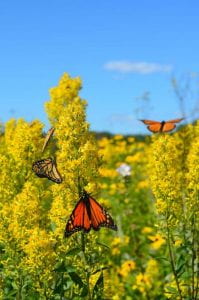The past few years have seen a tremendous increase in interest in pollinator gardening. This interest is fueled by the disease and health issues of our honey bees, the known declines in Monarch butterfly populations, and the apparent trouble our other native pollinators are in, all of which are becoming national concerns. Thankfully, the media has done an excellent job in educating the public on the important role pollinators play not only in our food system, but also in overall ecosystem health, and have brought attention to the worrisome declines.

The serious loss of pollinators has increased the desire of many gardeners to help reverse this decline and see what they can do to help maintain and improve habitats for pollinators. This is where the interest in developing pollinator gardens comes into play. But where does the average gardener gain the necessary knowledge to design a successful pollinator garden? There are many questions to answer: Which flowering plants are best for pollinators? What plants can diversify and extend the nectar available throughout the growing season? Should only native plants be used? Do some of our commonly planted annual and perennial flowers do the job? Walking into a big box store or nursery can leave you as confused as ever with so many choices, but only sparse information.
I was musing about all these issues the other day when a catalog arrived in the mail from Prairie Moon Nursery located in Winona, Minnesota. Prairie Moon Nursery specializes in native seeds and plants for gardening and environmental restoration.
What I found compelling about this catalog is the fact that Prairie Moon has already curated collections of native plant varieties that are known to be utilized by pollinators and which bloom from spring to fall.
Prairie Moon does the thinking and research for you, putting together ready-made pollinator garden “kits” with plants ready to go into the ground come spring. Based on the size of your garden and your budget, you can select from kits of 18 to 50 plants which will cover 50 to 150 square feet. Prairie Moon also provides the option of purchasing individual plants, or of purchasing seeds to start your own plants and save money.
Prairie Moon is by no means the only company filling this niche. Bluestone Perennials is another nursery provider of perennial flowering plants that offers ready-to-go pollinator gardens collections. Over a number of years I have had excellent success with purchasing perennial flowers from Bluestone. One thing I’ve appreciated about Bluestone is that they list the hardiness zone in which their plants will survive. Remember that for the greatest success in plant establishment in St. Lawrence County, only purchase plants best suited for growing zones 3 or 4. Never purchase plants for zones 6 or higher.

Also, take a look at what Northeast Pollinator Plants nursery has for sale. They sell only pollinator-friendly native and naturalized plants to New York and New England. They have a great section called “Planting for Pollinators.”
Search the internet for more suppliers, but always seek out plant varieties that are native to your area and will survive in your plant hardiness zone.
To learn more about native pollinator plants that grow in our region, check out the Xerces Society for Invertebrate Conservation’s website.
Garden Based Learning at Cornell University has produced a wonderful free publication titled “Creating a Pollinator Garden for Native Specialist Bees,” focusing on New York and the Northeast. Use the link to view and download this guide.
Time to start planning your pollinator garden… Happy Gardening!
Ken Kogut has been a Master Gardener Volunteer since 2014. A retired NY DEC Natural Resource Supervisor and Wildlife Biologist, Ken now spends his time maintaining his garden, berry patches, and small orchard with a goal of living sustainably off his property. He particularly enjoys helping county residents solve their gardening issues, writing short articles for gardeners, and teaching new gardeners in Seed to Supper classes.
